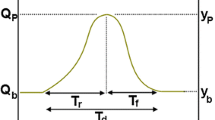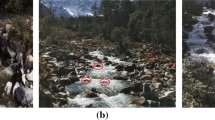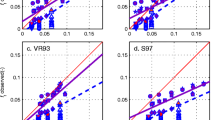Abstract
The presence of floaters should be taken into account when dealing with hydraulic analyses, e.g. when boats are moored along the river banks or large wood is expected to be conveyed by the river flow during floods. Many approaches have been proposed so far in order to consider the effects of floaters upon the flow features. Usually, they rely on the numerical resolution of the governing equation for both the fluid and the solid phases. Hence, their computational cost can be inadequate at the early stage of hydraulic studies or when large scale analyses have to be performed. A simplified method to compute the value of the resistance coefficient able to reproduce the effects of floaters upon the flow levels is proposed herein. The method is intended to provide the hydraulic parameters to be used within standard hydraulic simulations for which the effects of floaters must be accounted for; this is obtained by means of a modified resistance coefficient.





Similar content being viewed by others
References
Abbe TB, Montgomery DR (1996) Large woody debris jams, channel hydraulics and habitat formation in large rivers. Regul Rivers Res Manag 12(2–3):201–221
Amicarelli A, Albano R, Mirauda D, Agate G, Sole A, Guandalini R (2015) A smoothed particle hydrodynamics model for 3D solid body transport in free surface flows. Comput Fluids 116:205–228
Bates PD, Marks KJ, Horrit MS (2003) Optimal use of high resolution topographic data in flood inundation models. Hydrol Process 17:537–557
Bocchiola D (2011) Hydraulic characteristics and habitat suitability in presence of woody debris: a flume experiment. Adv Water Resour 34(10):1304–1319
Braudrick CA, Grant GE, Ishikawa Y, Ikeda H (1997) Dynamics of wood transport in streams: a flume experiment. Earth Surf Process Landf J Br Geomorphol Group 22(7):669–683
Cook A, Merwade V (2009) Effect of topographic data, geometric configuration and modelling approach on flood inundation mapping. J Hydrol 377:131–142
Cunge JA, Holly FM, Vervey A (1980) Practical aspects of computational river hydraulics. Pitman Publishing Inc, Boston
DHI (2007) River and channel hydraulics, a tool used for 1d numerical river modelling. DHI Water and Environment, Delft
Di Risio M, Bruschi A, Lisi I, Pesarino V, Pasquali D (2017) Comparative analysis of coastal flooding vulnerability and hazard assessment at national scale. J Mar Sci Eng 5:51
Gippel CJ, O’Neill IC, Finlayson BL, Schnatz INGO (1996) Hydraulic guidelines for the re-introduction and management of large woody debris in lowland rivers. Regul River 12(23):223–236
Hoang MC, Laneville A, Légeron F (2015) Experimental study on aerodynamic coefficients of yawed cylinders. J Fluid Struct 54:597–611
Horritt MS, Bates PD (2002) Evaluation of 1D and 2D numerical models for predicting river flood inundation. J Hydrol 268:87–99
Hygelund B, Manga M (2003) Field measurements of drag coefficients for model large woody debris. Geomorphology 51(1–3):175–185
Kim J, Ivanov VY, Katopodes ND (2012) Hydraulic resistance to overland flow on surfaces with partially submerged vegetation. Water Resour Res 48(10):W10540
Manga M, Kirchner JW (2000) Stress partitioning in streams by large woody debris. Water Resour Res 36(8):2373–2379
Medeiros SC, Hagen SC, Weishampel JF (2012) Comparison of floodplain surface roughness parameters derived from land cover data and field measurements. J Hydrol 452:139–149
Natale E, Petaccia G (2013) ORSADEM: a one dimension shallow water code for flood inundation modelling. J Irrig Drain 62(2):29–40
NavFaC (Naval Facilities Engineering Command) (1985) Fleet moorings, basic criteria and planning guidelines, design manual 26.5. Naval Facilities Engineering Service Center, Washington, DC
Pappenberger F, Beven K, Horritt M, Blazkova S (2005) Uncertainty in the calibration of effective roughness parameters in HEC-RAS using inundation and downstream level observations. J Hydrol 302:46–69
Percival S, Hendrix D, Noblesse F (2001) Hydrodynamic optimization of ship hull forms. Appl Ocean Res 23(6):337–355
Persi E, Petaccia G, Sibilla S, Brufau P, García-Navarro P (2018) Calibration of a dynamic Eulerian–lagrangian model for the computation of wood cylinders transport in shallow water flow. J Hydroinform 21(1):164–179
Persi E, Petaccia G, Fenocchi A, Manenti S, Ghilardi P, Sibilla S (2019) Hydrodynamic coefficients of yawed cylinders in open-channel flow. Flow Meas Instrum. https://doi.org/10.1016/j.flowmeasinst.2019.01.006
Petaccia G, Persi E, Sibilla S, Brufau P, García-Navarro P (2018) Enhanced one-way coupled SWE-DE model for floating body transport. Ital J Eng Geol Environ. Special Issue 1 (2018):161–172
Rhee DS, Woo H, Kwon B, Ahn HK (2008) Hydraulic resistance of some selected vegetation in open channel flows. River Res Appl 24(5):673–687
Ruiz-Villanueva V, Bladé E, Sánchez-Juny M, Marti-Cardona B, Díez-Herrero A, Bodoque JM (2014) Two-dimensional numerical modeling of wood transport. J Hydroinf 16(5):1077–1096
Sammarco P, di Risio M (2017) Effects of moored boats on the gradually varied free-surface profiles of river flows. J Water Port Coast Ocean Eng 143(3):04016020
Sanders BF, Schubert JE, Detwiler RL (2010) ParBreZo: a parallel, unstructured grid, Godunov-type, shallow-water code for high-resolution flood inundation modeling at the regional scale. Adv Water Resour 33(12):1456–1467
Schalko I, Schmocker L, Weitbrecht V, Boes RM (2018) Backwater rise due to large wood accumulations. J Hydraul Eng 144(9):04018056
Seelig WN, Kriebel D, Headland J (1992) Broadside current forces on moored ships. Proceedings of Civil Engineering in the Oceans V, ASCE, Reston, pp. 326–340
Shields FD Jr, Gippel CJ (1995) Prediction of effects of woody debris removal on flow resistance. J Hydraul Eng 121(4):341–354
Shields FD Jr, Alonso CV (2012) Assessment of flow forces on large wood in rivers. Water Resour Res 48:W04516. https://doi.org/10.1029/2011WR011547
SOBEK3\_TRM (2013) SOBEK 3/hydrodynamics technical reference manual/SOBEK in delta shell. Deltares, Delft. Version: 3.0.1.27817
Song S, Schmalz B, Zhang JX, Li G, Fohrer N (2017) Application of modified Manning formula in the determination of vertical profile velocity in natural rivers. Hydrol Res 48(1):133–146
Turcotte B, Millar RG, Hassan MA (2015) Drag forces on large cylinders. River Res Appl 32:411–417. https://doi.org/10.1002/rra.2868
USACE (1997) HEC-RAS. River analysis system. Hydrologic Engineering Centre, Davis
Vacondio R, Aureli F, Ferrari A, Mignosa P, Dal Palù A (2016) Simulation of the January 2014 flood on the Secchia river using a fast and high-resolution 2D parallel shallow-water numerical scheme. Nat Hazards 80(1):103–125
Wohl E, Bledsoe BP, Fausch KD, Kramer N, Bestgen KR, Gooseff MN (2016) Management of large wood in streams: an overview and proposed framework for hazard evaluation. JAWRA J Am Water Resour Assoc 52(2):315–335
Author information
Authors and Affiliations
Corresponding author
Additional information
Publisher's Note
Springer Nature remains neutral with regard to jurisdictional claims in published maps and institutional affiliations.
Rights and permissions
About this article
Cite this article
Di Risio, M., Sammarco, P. Effects of floaters on the free surface profiles of river flows. Environ Fluid Mech 20, 527–537 (2020). https://doi.org/10.1007/s10652-019-09710-z
Received:
Accepted:
Published:
Issue Date:
DOI: https://doi.org/10.1007/s10652-019-09710-z




